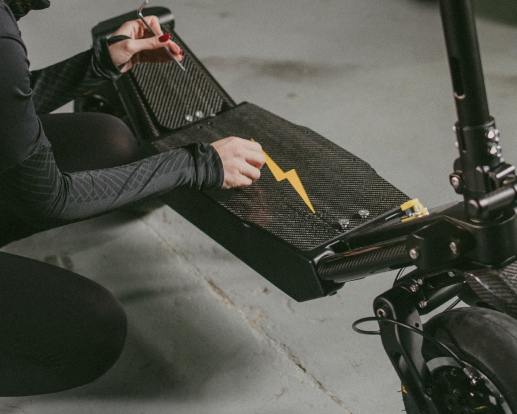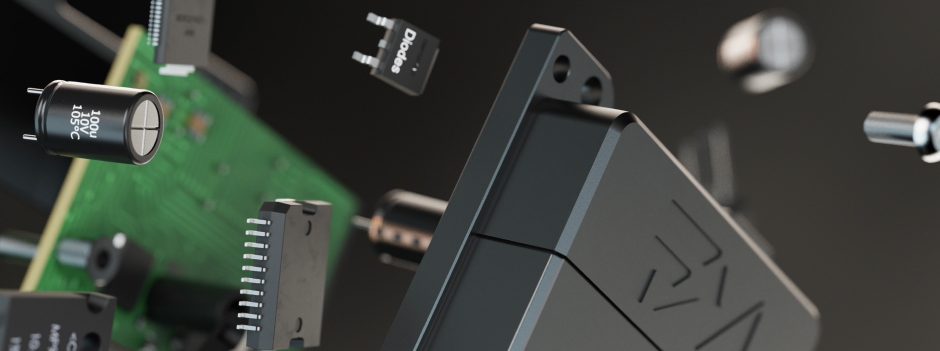
Electric scooters have become a popular mode of urban transportation in the modern age. However, like any technology, they can sometimes experience issues. Here are some troubleshooting tips to help you diagnose and fix common problems.

Check the Battery: Ensure the battery is fully charged. If it’s been unused for a long period, the battery may have entered a deep discharge state and might need a longer charging period to wake up.
Inspect the Charger: Verify that the charger and its connections are working correctly. Use a multimeter to check the output voltage.
Battery Care: Regularly draining the battery completely can reduce its lifespan and capacity. Try to keep the charge above 20%.
Motor Overheating: Overloading the scooter or climbing steep hills frequently can overheat the motor. Allow it to cool down periodically.
Check Connections: Ensure all charging connections are secure and clean. Corrosion or debris can prevent efficient charging.
Inspect the Charging Port and Cable: Look for any damage or bent pins in the charging port and cable.
Tighten Screws and Bolts: Regular use can loosen hardware. Periodically check and tighten them.
Wheel and Tire Check: Ensure the tires are properly inflated and the wheels are not damaged. Unusual noises can also stem from debris caught in the wheel or motor.
Brake Adjustment: If brakes are too tight or too loose, adjust them according to the scooter’s manual.
Check Brake Pads: Worn-out brake pads need replacement to ensure safety.
Clean Throttle and Handlebar Controls: Dirt and grime can cause stickiness or resistance in the throttle mechanism.
Firmware Update: Ensure your scooter’s firmware is up to date. Manufacturers sometimes release updates to fix bugs or improve performance.
Check Bulbs and LEDs: Replace any burned-out bulbs or LEDs.
Inspect Wiring: Loose or damaged wires can cause lights to malfunction. Ensure all connectors are properly seated.
Routine Checks: Regularly inspect your scooter for signs of wear and tear.
Storage: If not used for an extended period, store the scooter in a dry, cool place and periodically charge the battery.
Professional Service: For issues beyond basic troubleshooting, consult a professional service or the manufacturer.

While many electric scooter issues can be fixed at home with some basic troubleshooting knowledge, it’s important to recognize when a problem requires professional assistance. Always refer to the scooter’s user manual for specific maintenance advice and safety warnings. Safe riding!
Introduction: Navigating the Urban Mobility Choice The electric revolution has changed...
Introduction: Embracing the E-Scooter Revolution Electric scooters ceased to be trendy...
Electric scooters have gained popularity as a convenient and environmentally friendly...

72 Volts 30 Ah (2016Wh charge)
Equipped with a long-lasting battery for extended rides and adventures

Dual 3000W BLDC Hub Motors
Powerful dual-engine setup delivers dynamic performance for performance seekers

6 hours fast charging so you can spend less time waiting and more time exploring

110 km/h
Top-tier speed capabilities for the rush of wind and the thrill of pace

100 km
Ready for long journeys with a generous range that keeps you moving

120 kg
Robust build accommodates significant weight, ensuring a ride for all

Disk brake with dual 8 pistons (Front and Rear), E-Brake Included

PMT Italian Slick & Stradale 11-inch tubeless
High-quality tires designed for optimal traction and control in various conditions.

1230 mm
Streamlined design ensures a compact footprint for agile urban navigation.

1290 mm
Elevated stance provides a commanding view of the road ahead.

266 mm
Narrow build offers convenient maneuverability through tight spaces.

540 mm
Quick-fold mechanism reduces the scooter to a compact form for easy storage and portability.

Carbon fiber and CNC 6061 aluminum

IPX67-rated components

Optimized for minimal air resistance

Enjoy peace of mind with a comprehensive warranty covering your scooter

Complete with essential accessories, get everything you need to hit the road immediately

Two 150 AMP Nano Elite X5K
Precision control at your fingertips with advanced, customizable settings."

Choose from classic color options to match your style

72 Volts 30 Ah (2016Wh charge)
Equipped with a long-lasting battery for extended rides and adventures

Dual 3000W BLDC Hub Motors
Powerful dual-engine setup delivers dynamic performance for performance seekers

6 hours fast charging so you can spend less time waiting and more time exploring

110 km/h
Top-tier speed capabilities for the rush of wind and the thrill of pace

100 km
Ready for long journeys with a generous range that keeps you moving

120 kg
Robust build accommodates significant weight, ensuring a ride for all

Disk brake with dual 8 pistons (Front and Rear), E-Brake Included

PMT Slick Italian 11-inch
High-quality tires designed for optimal traction and control in various conditions.

1230 mm
Streamlined design ensures a compact footprint for agile urban navigation.

1290 mm
Elevated stance provides a commanding view of the road ahead.

266 mm
Narrow build offers convenient maneuverability through tight spaces.

540 mm
Quick-fold mechanism reduces the scooter to a compact form for easy storage and portability.

Carbon fiber and CNC 6061 aluminum

IPX67-rated components

Optimized for minimal air resistance

Enjoy peace of mind with a comprehensive warranty covering your scooter

Two 150 AMP Nano Elite X5K
Precision control at your fingertips with advanced, customizable settings."

Choose from classic color options to match your style

60 Volts 30 Ah (2016Wh charge)
Equipped with a long-lasting battery for extended rides and adventures

Dual 3000W BLDC Hub Motors
Powerful dual-engine setup delivers dynamic performance for performance seekers

6 hours fast charging so you can spend less time waiting and more time exploring

110 km/h
Top-tier speed capabilities for the rush of wind and the thrill of pace

100 km
Ready for long journeys with a generous range that keeps you moving

120 kg
Robust build accommodates significant weight, ensuring a ride for all

Disk brake with dual 8 pistons (Front and Rear), E-Brake Included

Front and Rear Single Absorbers
Smooth rides guaranteed with a suspension system that absorbs shocks and jolts

PMT Italian Stradale 11-inch tubeless
High-quality tires designed for optimal traction and control in various conditions.

1170 mm
Streamlined design ensures a compact footprint for agile urban navigation.

1250 mm
Elevated stance provides a commanding view of the road ahead.

241 mm
Narrow build offers convenient maneuverability through tight spaces.

470 mm
Quick-fold mechanism reduces the scooter to a compact form for easy storage and portability.

Carbon fiber and CNC 6061 aluminum

IPX67-rated components

Optimized for minimal air resistance

Enjoy peace of mind with a comprehensive warranty covering your scooter

Complete with essential accessories, get everything you need to hit the road immediately

Safety first with a helmet that combines comfort with protection

Two 150 AMP Nano Elite X5K
Precision control at your fingertips with advanced, customizable settings."

Choose from classic color options to match your style

60 Volts 30 Ah (2016Wh charge)
Equipped with a long-lasting battery for extended rides and adventures

Single 3000W BLDC Hub
Powerful dual-engine setup delivers dynamic performance for performance seekers

6 hours fast charging so you can spend less time waiting and more time exploring

100 km/h
Top-tier speed capabilities for the rush of wind and the thrill of pace

100 km
Ready for long journeys with a generous range that keeps you moving

120 kg
Robust build accommodates significant weight, ensuring a ride for all

Disk brake with dual 8 pistons (Front and Rear), E-Brake Included

Front and Rear Single Absorbers
Smooth rides guaranteed with a suspension system that absorbs shocks and jolts

PMT Italian Stradale 11-inch tubeless
High-quality tires designed for optimal traction and control in various conditions.

1170 mm
Streamlined design ensures a compact footprint for agile urban navigation.

1250 mm
Elevated stance provides a commanding view of the road ahead.

241 mm
Narrow build offers convenient maneuverability through tight spaces.

470 mm
Quick-fold mechanism reduces the scooter to a compact form for easy storage and portability.

Carbon fiber and CNC 6061 aluminum

IPX67-rated components

Optimized for minimal air resistance

Enjoy peace of mind with a comprehensive warranty covering your scooter

One 150 AMP Nano Elite X5K
Precision control at your fingertips with advanced, customizable settings."

Choose from classic color options to match your style
One of our specialists will be in touch within the next 24-48 hours to assist you. We appreciate your interest in our scooters and look forward to speaking with you soon!”

72 Volts 30 Ah (2016Wh charge)
Equipped with a long-lasting battery for extended rides and adventures

Dual 3000W BLDC Hub Motors
Powerful dual-engine setup delivers dynamic performance for performance seekers

6 hours fast charging so you can spend less time waiting and more time exploring

110 km/h
Top-tier speed capabilities for the rush of wind and the thrill of pace

100 km
Ready for long journeys with a generous range that keeps you moving

120 kg
Robust build accommodates significant weight, ensuring a ride for all

Disk brake with dual 8 pistons (Front and Rear), E-Brake Included

PMT Italian Slick & Stradale 11-inch tubeless
High-quality tires designed for optimal traction and control in various conditions.

1230 mm
Streamlined design ensures a compact footprint for agile urban navigation.

1290 mm
Elevated stance provides a commanding view of the road ahead.

266 mm
Narrow build offers convenient maneuverability through tight spaces.

540 mm
Quick-fold mechanism reduces the scooter to a compact form for easy storage and portability.

Carbon fiber and CNC 6061 aluminum

IPX67-rated components

Optimized for minimal air resistance

Enjoy peace of mind with a comprehensive warranty covering your scooter

Complete with essential accessories, get everything you need to hit the road immediately

Two 150 AMP Nano Elite X5K
Precision control at your fingertips with advanced, customizable settings."

Choose from classic color options to match your style

72 Volts 30 Ah (2016Wh charge)
Equipped with a long-lasting battery for extended rides and adventures

Dual 3000W BLDC Hub Motors
Powerful dual-engine setup delivers dynamic performance for performance seekers

6 hours fast charging so you can spend less time waiting and more time exploring

110 km/h
Top-tier speed capabilities for the rush of wind and the thrill of pace

100 km
Ready for long journeys with a generous range that keeps you moving

120 kg
Robust build accommodates significant weight, ensuring a ride for all

Disk brake with dual 8 pistons (Front and Rear), E-Brake Included

PMT Slick Italian 11-inch
High-quality tires designed for optimal traction and control in various conditions.

1230 mm
Streamlined design ensures a compact footprint for agile urban navigation.

1290 mm
Elevated stance provides a commanding view of the road ahead.

266 mm
Narrow build offers convenient maneuverability through tight spaces.

540 mm
Quick-fold mechanism reduces the scooter to a compact form for easy storage and portability.

Carbon fiber and CNC 6061 aluminum

IPX67-rated components

Optimized for minimal air resistance

Enjoy peace of mind with a comprehensive warranty covering your scooter

Two 150 AMP Nano Elite X5K
Precision control at your fingertips with advanced, customizable settings."

Choose from classic color options to match your style

60 Volts 30 Ah (2016Wh charge)
Equipped with a long-lasting battery for extended rides and adventures

Dual 3000W BLDC Hub Motors
Powerful dual-engine setup delivers dynamic performance for performance seekers

6 hours fast charging so you can spend less time waiting and more time exploring

110 km/h
Top-tier speed capabilities for the rush of wind and the thrill of pace

100 km
Ready for long journeys with a generous range that keeps you moving

120 kg
Robust build accommodates significant weight, ensuring a ride for all

Disk brake with dual 8 pistons (Front and Rear), E-Brake Included

Front and Rear Single Absorbers
Smooth rides guaranteed with a suspension system that absorbs shocks and jolts

PMT Italian Stradale 11-inch tubeless
High-quality tires designed for optimal traction and control in various conditions.

1170 mm
Streamlined design ensures a compact footprint for agile urban navigation.

1250 mm
Elevated stance provides a commanding view of the road ahead.

241 mm
Narrow build offers convenient maneuverability through tight spaces.

470 mm
Quick-fold mechanism reduces the scooter to a compact form for easy storage and portability.

Carbon fiber and CNC 6061 aluminum

IPX67-rated components

Optimized for minimal air resistance

Enjoy peace of mind with a comprehensive warranty covering your scooter

Complete with essential accessories, get everything you need to hit the road immediately

Safety first with a helmet that combines comfort with protection

Two 150 AMP Nano Elite X5K
Precision control at your fingertips with advanced, customizable settings."

Choose from classic color options to match your style

60 Volts 30 Ah (2016Wh charge)
Equipped with a long-lasting battery for extended rides and adventures

Single 3000W BLDC Hub
Powerful dual-engine setup delivers dynamic performance for performance seekers

6 hours fast charging so you can spend less time waiting and more time exploring

100 km/h
Top-tier speed capabilities for the rush of wind and the thrill of pace

100 km
Ready for long journeys with a generous range that keeps you moving

120 kg
Robust build accommodates significant weight, ensuring a ride for all

Disk brake with dual 8 pistons (Front and Rear), E-Brake Included

Front and Rear Single Absorbers
Smooth rides guaranteed with a suspension system that absorbs shocks and jolts

PMT Italian Stradale 11-inch tubeless
High-quality tires designed for optimal traction and control in various conditions.

1170 mm
Streamlined design ensures a compact footprint for agile urban navigation.

1250 mm
Elevated stance provides a commanding view of the road ahead.

241 mm
Narrow build offers convenient maneuverability through tight spaces.

470 mm
Quick-fold mechanism reduces the scooter to a compact form for easy storage and portability.

Carbon fiber and CNC 6061 aluminum

IPX67-rated components

Optimized for minimal air resistance

Enjoy peace of mind with a comprehensive warranty covering your scooter

One 150 AMP Nano Elite X5K
Precision control at your fingertips with advanced, customizable settings."

Choose from classic color options to match your style
I, hereby acknowledge that I have read, understood, and agree to be bound by the Terms and Service (“Terms”) outlined by Flashmotors LTD in relation to the purchase and use of their scooters. By accepting these Terms, I affirm that I am of legal age and possess the necessary authority to enter into this agreement.
I specifically acknowledge and agree to the following:
1. Legal Notice: I am aware that the scooters provided by Flashmotors LTD are intended for personal use and must be operated in compliance with all applicable laws and regulations of Cyprus.
2. Withdrawal, Return, Refund, and Cancellation Policy: I understand that as per Cyprus law, I have the right to withdraw from the purchase contract within 14 days of receiving the Product. I agree to follow the specified procedures regarding withdrawal, return, and refund, including returning the Product in its original condition.
4. Complaint Policy: In the event of any issues or concerns with the Product, I agree to promptly contact the customer service team of Flashmotors LTD providing necessary information to assist in resolving the complaint.
5. Liabilities under Cyprus Law: I acknowledge that any liability or obligation arising from these Terms is subject to the laws and regulations of Cyprus. I understand that any dispute related to these Terms shall be subject to the exclusive jurisdiction of the courts of Cyprus.
6. Acceptance of Communication Terms: By providing your contact information and checking the designated boxes during account registration, or by entering your contact details on Flashmotors.com, you expressly consent to receive promotional and informational communications via SMS and email from Flashmotors.
I further acknowledge that Flashmotors LTD reserves the right to modify or update these Terms at any time, with the revised Terms becoming effective immediately upon posting on their website.
By accepting these Terms and Conditions, I confirm that I have reviewed and understood all the provisions contained therein, and I agree to be bound by them in their entirety.